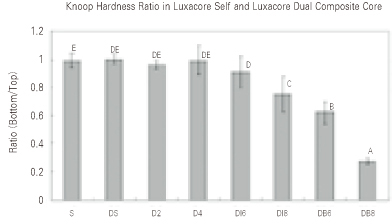J Korean Acad Conserv Dent.
2006 Sep;31(5):352-358. 10.5395/JKACD.2006.31.5.352.
Influence of thickness on the degree of cure of composite resin core material
- Affiliations
-
- 1Department of Conservative Dentistry, School of Dentistry, Kyungpook National University, Daegu, Korea.
- 2Department of Conservative Dentistry, College of Dentistry, Yonsei University, Seoul, Korea. pjw@yumc.yonsei.ac.kr
- KMID: 1986878
- DOI: http://doi.org/10.5395/JKACD.2006.31.5.352
Abstract
- The purpose of this study was to investigate the influence of thickness on the degree of cure of dual-cured composite core. 2, 4, 6, 8 mm thickness Luxacore Dual and Luxacore Self (DMG Inc, Hamburg, Germany) core composites were cured by bulk or incremental filling with halogen curing unit or self-cure mode. The specimens were stored at 37degrees C for 24 hours and the Knoop's hardness of top and bottom surfaces were measured. The statistical analysis was performed using ANOVA and Tukey's test at p = 0.05 significance level. In self cure mode, polymerization is not affected by the thickness. In Luxacore dual, polymerization of the bottom surface was effective in 2, 4 and 6 (incremental) mm specimens. However the 6 (bulk) and 8 (bulk, incremental) mm filling groups showed lower bottom/top hardness ratio (p < 0.05). Within the limitation of this experiment, incremental filling is better than bulk filling in case of over 4 mm depth, and bulk filling should be avoided.
Keyword
MeSH Terms
Figure
Cited by 1 articles
-
Effect of curing modes on micro-hardness of dual-cure resin cements
Ki-Deok Lee, Se-Hee Park, Jin-Woo Kim, Kyung-Mo Cho
J Korean Acad Conserv Dent. 2011;36(2):132-138. doi: 10.5395/JKACD.2011.36.2.132.
Reference
-
1. Soh MS, Yap AUJ, Siow KS. Effectiveness of composite cure associated with different curing modes of LED lights. Oper Dent. 2003. 28:371–377.2. Yap AUJ. impact of cavity depth and exposure time. Oper Dent. 2000. 25:113–120.3. Soh MS, Yap AUJ, Siow KS. The Effectiveness of cure of LED and halogen curing lights at varying cavity depths. Oper Dent. 2003. 28:707–715.4. Bala O, Uctasli MB, Tuz MA. Barcoll hardness of different resin-based composites cured by halogen or light emitting diode (LED). Oper Dent. 2005. 30:69–74.5. Pilo R, Cardash HS. Post-irradiation polymerization of different anterior and posterior visible light-activated resin composites. Dent Mater. 1992. 8:299–304.
Article6. Sharp LJ, Yin R, Kang WH, Suh BI. Comparison of curing of resin cements. J Dent Res. 2005. Abst # 1847.7. Asmussen E. hardness and strength vs quantity of remaining double bonds. Scand J Dent Res. 1982. 90:484–489.8. Poskus LT, Placido E, Cardoso PE. Influence of placement techniques on vickers and knoop hardness of class II composite resin restorations. Dent Mater. 2004. 20:726–732.
Article9. Jandt KD, Mills RW, Blackwell GB, Ashworth SH. Depth of cure and compressive strength of dental composites cured with blue light emitting diodes (LEDs). Dent Mater. 2000. 16:41–47.
Article10. Dewald JP, Ferracane JL. A comparison of four modes of evaluating depth of cure of light-activated composites. J Dent Res. 1987. 66:727–730.
Article11. Bayne SC, Heymann HO, Swift EJ Jr. Update on dental composite restorations. J Am Dent Assoc. 1994. 125:687–701.
Article12. Roulet JF. Benefits and disadvantages of tooth-colored alternatives to amalgam. J Dent. 1997. 25:459–473.13. Rueggeberg FA, Caughman WF, Curtis JW Jr. Effect of light intensity and exposure duration on cure of resin composite. Oper Dent. 1994. 19:26–32.14. Rueggeberg FA, Jordan DM. Effect of light-tip distance on polymerization of resin composite. Int J Prosthodont. 1993. 6:364–370.15. Ruyter IE, ôysaed H. Conversion in different depths of ultraviolet and visible light activated composite materials. Acta Odontol Scand. 1982. 40:179–192.
Article16. Yearn JA. Factors affecting cure of visible light activated composites. Int Dent J. 1985. 35:218–225.17. Watts DC, Amer O, Combe EC. Characteristics of visible light-activated composite systems. Br Dent J. 1984. 156:209–215.
Article18. Lovell LG, Newman SM, Bowman CN. The effects of light intensity, temperature, and comonomer composition on the polymerization behavior of dimethacrylate dental resins. J Dent Res. 1999. 78:1469–1476.
Article
- Full Text Links
- Actions
-
Cited
- CITED
-
- Close
- Share
- Similar articles
-
- The effect of thickness and translucency of polymer-infiltrated ceramic-network material on degree of conversion of resin cements
- Comparison of polymerization shrinkage of dual-cure core build-up resin according to shade and curing mode
- Degree of conversion of resin composite cured by light through a translucent fiber posts
- FRACTURE TOUGHNESS OF VARIOUS CORE MATERIALS
- Influence of the color of composite resins applied to lingual surface on the labial tooth color


